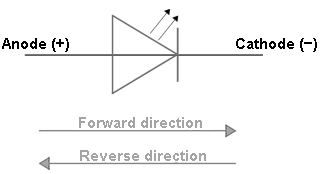Definition
An LED (light-emitting diode) converts electrical energy into light. An LED consists of a semiconductor p-n junction. Like a conventional semiconductor diode, an LED is forward-biased and reverse-biased. When applying a voltage in the forward direction, surplus electrons in the semiconductor recombine with the electron holes. The LED becomes conductive and energy is given off in the form of light. The energy and thus the light color depend on the semiconducting material used.
The electrical circuit symbol for an LED shows a diode with two arrows. These arrows symbolize the emitted light.
 Fig.9: Circuit symbol for an LED
Fig.9: Circuit symbol for an LED